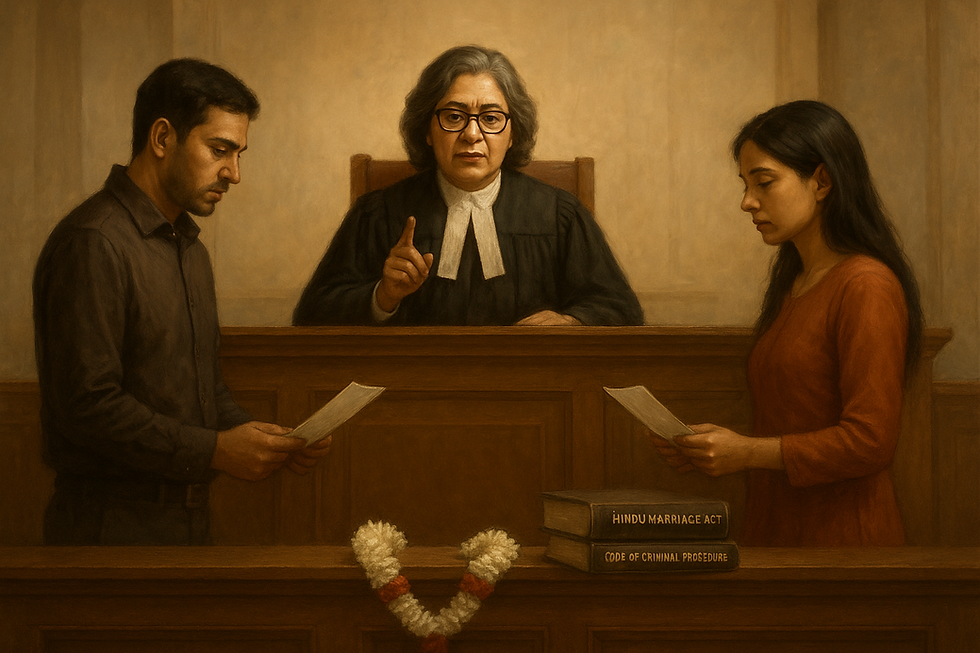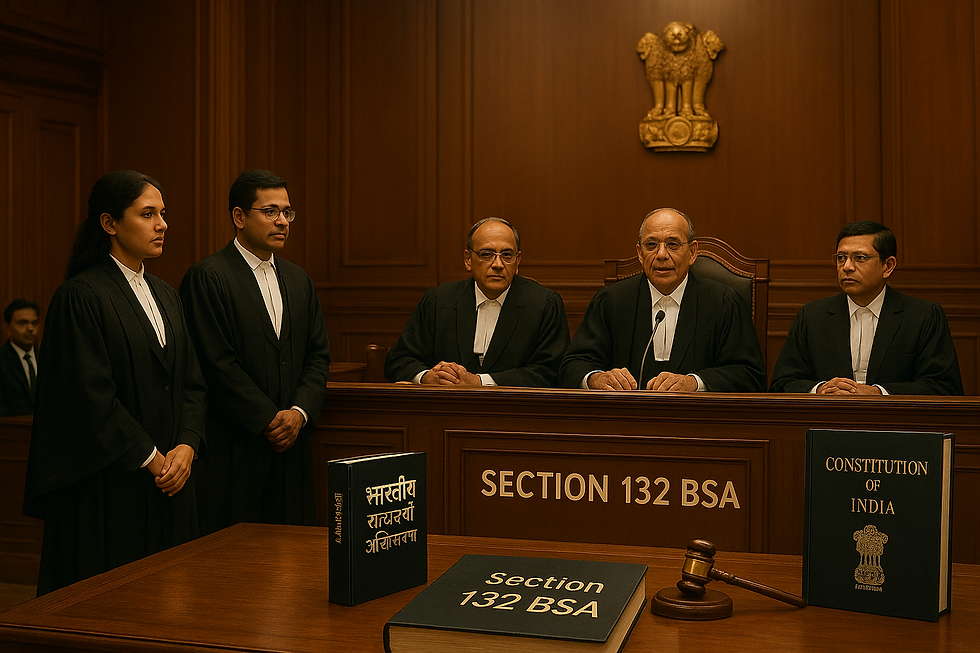Substance Over Title: Supreme Court Says Legal Notice Valid by Content, Not Label
- Lawttorney.ai

- Jun 9
- 5 min read
Context:
In law, precision matters. A misworded clause or an ill-timed filing can change the course of a case. But sometimes, the obsession with form takes over substance, a classic case of missing the forest for the trees. That’s exactly what the Supreme Court addressed in a recent judgment involving the Kamla Nehru Memorial Trust (KNMT) and Anr. Vs. the Uttar Pradesh State Industrial Development Corporation (UPSIDC) & Ors. The core question? Whether a communication must be explicitly labelled “legal notice” to be treated as one.
It may sound like a minor technicality. But the Court’s verdict delivered something far more meaningful: a signal that law must serve clarity and justice: not mere paperwork or ceremonial wording.

Background:
Land Allotment, Non-Compliance, and Legal Notice: The Battle Over Title and Content
The main issue of this case was a land allotment made to KNMT by UPSIDC: a state body tasked with industrial development. The trust had received land on the condition that it would be used within a specified time for a particular purpose. That didn’t happen.
UPSIDC waited. Then it sent letters. Eventually, after years of inaction, it cancelled the allotment.
The trust didn’t challenge the substance of that decision right away. Instead, it questioned the process: specifically, the notices. According to the UPSIDC's manual, cancellation of allotment required three legal notices. KNMT claimed it had received just one dated November 13, 2006 that was formally titled “legal notice.” The earlier two letters from 2004 and 2005, they argued, didn’t carry that formal label and should not count.
In essence, the trust’s legal strategy boiled down to this: only notices clearly stamped as ‘legal’ are legal.
Supreme Court’s Observation on Legal Notice Validity:
The Court’s Practical Approach: Legal Notice Validity Lies in Content Over Title
The Supreme Court in a ruling authored by Justice Surya Kant, with Justice N Kotiswar Singh concurring- didn’t buy that argument. And quite rightly so.
The justices took a broader, common-sense view. They looked at the substance of each of the three messages, not just their names. What they found was clear: the 2004 and 2005 letters were not casual reminders. They referenced earlier correspondence, highlighted the breach (non-utilization of land), explained the potential consequences, and reflected a clear intent to take action if the default continued. In every meaningful way, these were notices: legal in spirit, legal in function.
In one of the striking observation, the Court remarked:
“It is beyond our comprehension as to what prejudice has really been caused to KNMT merely because these notices are not captioned as legal notices.”
That sentence, direct and slightly exasperated, hits the nail on the head. When the message is clear, must we really argue over the envelope?
Defining a Legal Notice: Four Simple Ingredients
For clarity, the Court went a step further and laid out what makes a notice “legal” in practical terms:
Clarity of facts: The notice must give a coherent background. Citing earlier communication or factual occurrences helps in maintaining continuity easier.
Identification of breach: It should highlight the default or noncompliance of the requirement.
Intent to take legal action: There must be a clear indication that legal action will be pursued if the issue is not resolved.
Transparency: The message should be clear, direct, and devoid of misleading or hidden elements.
These aren’t radical concepts. They’re what any reasonable person would expect from a formal warning or intimation. What the Court essentially did was distill legal notice into what it should’ve always been a meaningful and fair heads-up.
Supreme Court’s Ruling:
Substance, Not Semantics, Takes Center Stage
The conflict between UPSIDC and Kamla Nehru Memorial Trust might initially seem like just another administrative battle over a canceled land allocation. When the layers are removed, however, the Supreme Court's decision reveals something deeper: a confirmation that substance must take precedence over classification in legal interpretation. The Court’s decision decisively shifts the conversation from superficial formalities to the actual message conveyed. Was the breach communicated clearly? Did the recipient understand the consequences? Was there an intent to initiate legal consequences if compliance wasn’t achieved? If the answer to these is yes, then calling a letter a “legal notice” becomes less important than ensuring it functions as one.
In essence, the ruling reminds us that the power of legal communication lies in what is said and not in how it is labeled. For those outside the corridors of legal sophistication—individuals, small organizations, or public bodies—the judgment brings much-needed clarity. Legal intent doesn’t need to hide behind legalese or ceremonial tags. A straightforward, well-reasoned letter can carry the same legal weight as one draped in formality, as long as it communicates its purpose unambiguously. This pivot from rigid structure to practical substance helps demystify legal processes and upholds the principle that justice should be accessible, not obstructed by jargon.
A Footnote of Accountability: When Labels Aren’t the Only Issue
While the Court’s decision ultimately favoured UPSIDC, it didn’t let the authority walk away without scrutiny. The justices took note of an earlier incident where 125 acres were allocated to the trust within a mere two months and without inviting competitive bids. That detail, quietly tucked into the judgment, spoke volumes. It brought to light issues with procedural justice and openness in the administration of public funds.
By spotlighting this discrepancy, the Court offered more than just legal commentary—it delivered a subtle but unmistakable call for reform. It exhorted state agencies to hold themselves to the same procedural integrity and fairness standards that they demand of others. By doing this, the Supreme Court served as a reminder to all parties involved that justice is a two-way street. Fairness, after all, should be embedded not only in the rules, but in the rule-makers themselves.
Conclusion:
Justice, Not Jargon
If this ruling had a theme, it would be this: communication is judged by what it conveys, not what it’s called. The Supreme Court has drawn a line between procedural technicality and procedural justice and it’s a welcome distinction.
Lawyers often joke that in litigation, how you say something can be as important as what you say. This case reminds us that, actually, what you say and how clearly you say it should matter most.
At its core, the judgment reaffirms a principle that’s easy to forget in a system dense with process: that the law is a tool to facilitate justice, not obstruct it. If a notice delivers all the facts, issues a fair warning, and gives the recipient a chance to respond, it should be treated with the seriousness it deserves: label or no label.
FAQ Section:
Q1: What makes a notice a legal notice in India?
A: A notice becomes legal when it includes clear facts, identification of breach, intent to take legal action, and transparency—regardless of the label.
Q2: Can a letter without the title "Legal Notice" still be valid in court?
A: Yes. As ruled by the Supreme Court, the content and intent of the message determine its legal validity, not the presence of the label.
Q3: What did the Supreme Court say about legal notice titles?
A: The Court emphasized that a notice’s substance and clarity are more important than whether it’s explicitly called a "legal notice."
Empower Your Legal Practice with AI – Join Our Free Webinar!
Are you a legal professional looking to boost your efficiency and stay ahead in a competitive field? Discover the power of Lawttorney.AI – the cutting-edge tool designed to streamline legal research, automate tasks, and enhance productivity.
👉 Don't miss out! Reserve your spot in our FREE webinar and experience the future of legal practice today. Register Now




Comments